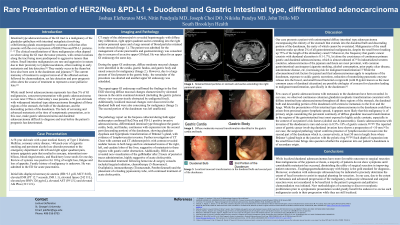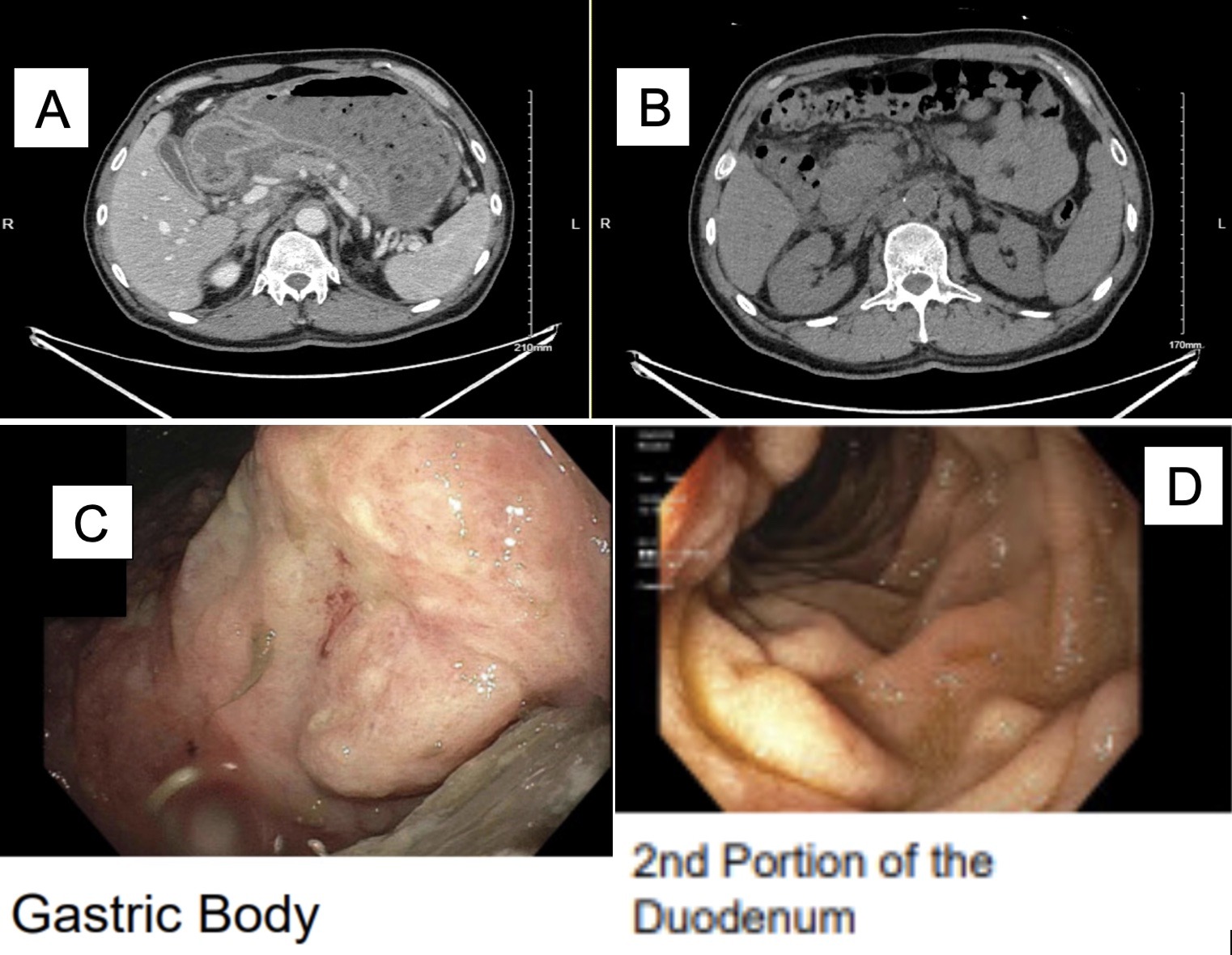Monday Poster Session
Category: Small Intestine
P3265 - Case Report: Rare Presentation of HER2/Neu and PD-L1 Positive Duodenal and Gastric Intestinal Type, Differentiated Adenocarcinoma
Monday, October 28, 2024
10:30 AM - 4:00 PM ET
Location: Exhibit Hall E

Has Audio

Joshua Elefteratos, BS
South Brooklyn Health
Brooklyn, NY
Presenting Author(s)
Joshua Elefteratos, BS1, Joseph Choi, DO1, Nitin Pendyala, MD2, Nikisha Pandya, MD1, John Trillo, MD2
1South Brooklyn Health, Brooklyn, NY; 2NYC Health + Hospitals/South Brooklyn Health, Brooklyn, NY
Introduction: Intestinal type adenocarcinoma of the GI tract is a malignancy of the glandular epithelium with intestinal metaplasia that often presents with the overexpression of HER2/Neu and PD-L1 proteins. Small intestine malignancies are rare and aggressive in nature due to their proximity to lymph vasculature, often resulting in early metastasis and late detection.
Case Description/Methods: Our case presents a 58-year-old male with a past medical history of type 2 DM, coronary artery disease, persistent alcohol use disorder and a 40+ pack year smoking history who presented to the ER with blood-tinged emesis, black tarry stools, left and right upper quadrant pain and intense epigastric pain resulting in syncope. Initial evaluation revealed normocytic anemia, elevated ALP and lipase concerning for pancreatitis, for which the patient was admitted.
Given the patient’s presenting symptoms and initial lab results, there was concern for an active GI bleed. CT angiography revealed a large amount of blood particles in the stomach and significant right upper quadrant ascites (Images A., B.). Same day EGD and repeat EGD with biopsy revealed ulcerated mucosa in the entirety of the stomach and localized mucosal changes concerning for malignancy throughout the stomach, with extension into the duodenal bulb and second part of the duodenum (Images C., D.). The pathology report confirmed Her2/Neu and PD-L1 positive invasive adenocarcinoma, differentiated intestinal type throughout the gastric cardia, body, and fundus, with continuous expansion into the descending portion of the duodenum, with evidence of invasion into the surrounding lymphovasculature.
Discussion: Malignancies of the small intestine make up a small percentage of GI malignancies. Malignancy of the stomach with concurrent duodenal ulceration, let alone malignancy, is even rarer. Our case is unique as there are few cases of gastric adenocarcinoma with invasion into the duodenum recorded. Our patient’s extensive risk factors for increased acidity within these regions of the GI tract and the continuity and direct extension of diffuse mucosal transformation into the second part of the duodenum suggests that the malignancy is of primary origin. The importance of reporting is to document the rare and evolving clinical presentation of stomach and duodenal malignancy and encourage the development of screening methods that can prompt earlier workup prior to symptomatic presentation of the illness, which for these malignancies, often signals an advanced progression.

Disclosures:
Joshua Elefteratos, BS1, Joseph Choi, DO1, Nitin Pendyala, MD2, Nikisha Pandya, MD1, John Trillo, MD2. P3265 - Case Report: Rare Presentation of HER2/Neu and PD-L1 Positive Duodenal and Gastric Intestinal Type, Differentiated Adenocarcinoma, ACG 2024 Annual Scientific Meeting Abstracts. Philadelphia, PA: American College of Gastroenterology.
1South Brooklyn Health, Brooklyn, NY; 2NYC Health + Hospitals/South Brooklyn Health, Brooklyn, NY
Introduction: Intestinal type adenocarcinoma of the GI tract is a malignancy of the glandular epithelium with intestinal metaplasia that often presents with the overexpression of HER2/Neu and PD-L1 proteins. Small intestine malignancies are rare and aggressive in nature due to their proximity to lymph vasculature, often resulting in early metastasis and late detection.
Case Description/Methods: Our case presents a 58-year-old male with a past medical history of type 2 DM, coronary artery disease, persistent alcohol use disorder and a 40+ pack year smoking history who presented to the ER with blood-tinged emesis, black tarry stools, left and right upper quadrant pain and intense epigastric pain resulting in syncope. Initial evaluation revealed normocytic anemia, elevated ALP and lipase concerning for pancreatitis, for which the patient was admitted.
Given the patient’s presenting symptoms and initial lab results, there was concern for an active GI bleed. CT angiography revealed a large amount of blood particles in the stomach and significant right upper quadrant ascites (Images A., B.). Same day EGD and repeat EGD with biopsy revealed ulcerated mucosa in the entirety of the stomach and localized mucosal changes concerning for malignancy throughout the stomach, with extension into the duodenal bulb and second part of the duodenum (Images C., D.). The pathology report confirmed Her2/Neu and PD-L1 positive invasive adenocarcinoma, differentiated intestinal type throughout the gastric cardia, body, and fundus, with continuous expansion into the descending portion of the duodenum, with evidence of invasion into the surrounding lymphovasculature.
Discussion: Malignancies of the small intestine make up a small percentage of GI malignancies. Malignancy of the stomach with concurrent duodenal ulceration, let alone malignancy, is even rarer. Our case is unique as there are few cases of gastric adenocarcinoma with invasion into the duodenum recorded. Our patient’s extensive risk factors for increased acidity within these regions of the GI tract and the continuity and direct extension of diffuse mucosal transformation into the second part of the duodenum suggests that the malignancy is of primary origin. The importance of reporting is to document the rare and evolving clinical presentation of stomach and duodenal malignancy and encourage the development of screening methods that can prompt earlier workup prior to symptomatic presentation of the illness, which for these malignancies, often signals an advanced progression.

Figure: Images A., B. Retained blood particles in the stomach and ascites extending into right pararenal space
Image C. Diffuse moderate mucosal transformation identified in the gastric body.
Image D. Localized mucosal transformation in the second part of the duodenum.
Image C. Diffuse moderate mucosal transformation identified in the gastric body.
Image D. Localized mucosal transformation in the second part of the duodenum.
Disclosures:
Joshua Elefteratos indicated no relevant financial relationships.
Joseph Choi indicated no relevant financial relationships.
Nitin Pendyala indicated no relevant financial relationships.
Nikisha Pandya indicated no relevant financial relationships.
John Trillo indicated no relevant financial relationships.
Joshua Elefteratos, BS1, Joseph Choi, DO1, Nitin Pendyala, MD2, Nikisha Pandya, MD1, John Trillo, MD2. P3265 - Case Report: Rare Presentation of HER2/Neu and PD-L1 Positive Duodenal and Gastric Intestinal Type, Differentiated Adenocarcinoma, ACG 2024 Annual Scientific Meeting Abstracts. Philadelphia, PA: American College of Gastroenterology.
